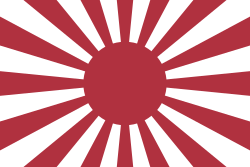| Imperial Japanese Army | |
|---|---|
 The ensign of the Imperial Japanese Army | |
| Founded | 1867 |
| Disbanded | 1945 |
| Headquarters | Tokyo |
| Leadership | |
| Tennō | Shōwa-tennō (昭和天皇) |
| Ministry of the Army 陸軍省, Rikugun-shō | Shunroku Hata Hideki Tōjō Hajime Sugiyama Korechika Anami Naruhiko Higashikuni Sadamu Shimomura |
| Chief of the General Staff 陸軍参謀総長, Rikugun Sanbō Sōchō | Kotohito Kan’in Hajime Sugiyama Hideki Tōjō Yoshijirō Umezu |
| Personnel | |
| Conscription | 17–40 |
The Pacific War lasted from 1941 to 1945, with the Empire of Japan fighting against the United States, the British Empire and their allies. Most of the campaign was fought on a variety of small islands in the Pacific region. Ground fighting in the Pacific was characterized by its intense ferocity, and combat conditions were marked by illness and logistical difficulties, especially for Japanese soldiers. The Imperial Japanese Army (IJA) typically fought alone in these engagements, often with very little naval or aerial support, and the IJA quickly garnered a reputation for tenacious resistance as well as brutality.
At the beginning of the Pacific War in 1941, the Imperial Japanese Army contained 51 divisions, 27 of which were stationed in China. A further 13 divisions defended the Manchurian–Soviet border, due to concerns about a possible attack by the Soviet Union.[1] From 1942 onwards, troops were sent to Hong Kong (23rd Army), the Philippines (14th Army), Thailand (15th Army), Burma (15th Army), the Dutch East Indies (16th Army), and Malaya (25th Army). A total of 5.473 million men served in the Imperial Japanese Army over the course of the war.
Japanese troops suffered from a shortage of supplies, especially food, medicine, munitions, and armaments, largely due to the crippling losses inflicted on Japan's merchant fleet by Allied submarines. Logistical issues were worsened by a longstanding rivalry with the Imperial Japanese Navy, with army and navy planners generally viewing support for the other as transactional instead of collaborative. As many as two-thirds of Japan's total military deaths were a result of illness or starvation.
- ^ Jowett 2002, p. 7.
© MMXXIII Rich X Search. We shall prevail. All rights reserved. Rich X Search
